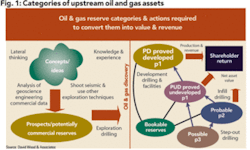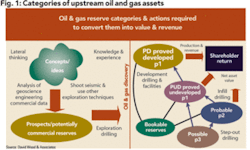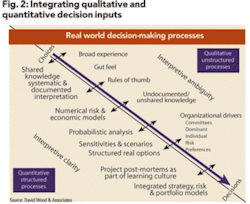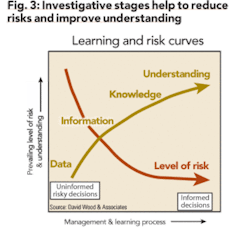MANAGING PORTFOLIOS:
Recognizing the value of unstructured information
David A. Wood
Consultant
Lincoln, England
The progress from a play concept to a drilled discovery and on to a field development with associated proven reserves follows the path of unstructured information and ideas in the mind of a geoscientist, to structured information associated with defining the detailed categories of reserves. The petroleum industry is familiar in dealing with both structured and unstructured information and recognizes that decisions have to be based on both types of information.
Fig. 1 illustrates this progression from potential to proven reserves. Decisions to drill the potential reserves of prospects are commonly based on a significant component of unstructured information (i.e. ideas, experience, a gut-feeling, intuition, etc.), while structured information involves numerical analysis, facts, and forecasts. As more information on a reservoir is obtained, the balance swings to include more structured information in the decision-making process.
Due to the uncertainty throughout the life cycle of an upstream asset and the nature of human decision-making, it is important not to lose sight of or undervalue the unstructured information that remains available and contributes to the decision-making process. The group of senior decision-makers in most organizations consists of individuals with varying levels of dependence on structured and unstructured information. Some are comfortable to rely on technological results coupled with rigorous numerical analysis to frame and assess options available for a decision. Some will ignore all structured analysis and rely on personal experience or intuition that is influenced by a wide range of peripheral, and sometimes totally unconnected, events. Some will acknowledge the reasoning behind the structured analysis but make a decision based solely on a political basis, or their own personal risk preferences or objectives, rather than the defined corporate strategic objectives.
Fig. 2 illustrates the complex interactions between the influences of structured and unstructured information in assessing options and making decisions under conditions of uncertainty that confront most corporate organizations. Even in organizations that invest in sophisticated models that provide detailed analyses and interpretation, most senior decision makers propose a decision based on these analyses only for the CEO to elect to adopt a decision option rejected by sound analysis. Many corporate boardrooms are anything but democratic!
Attempting to analyze and document why certain decisions were made becomes difficult in such circumstances, particularly if the corporate culture, or the image portrayed to shareholders, is that all decisions are based on sound, structured, and quantified processes. In these circumstances, the significant actual contribution of unstructured influences are effectively ignored. Project post-mortems (learning from mistakes and successes) also become difficult, and much less useful, as the numerous intuitive and ambiguous processes that went into the original decision-making process were either not documented or under-stated.
Some large organizations have acquired sophisticated and expensive software to numerically model the value and risk of their asset portfolios, but continue to rely primarily on unstructured influences when making key decisions pertaining to the portfolio. This happens for a variety of reasons. The model may be operated ineffectively, or it is presented to the senior decision-makers in such a way that they feel uncomfortable relying entirely on the structured information it provides.
Portfolio management groups and analysts within an organization that produce structured analysis evaluating project options should take into account that unstructured influences are also at work in the decision-making process. Portfolio managers and analysts must try and capture and document when, where, and how unstructured influences conflict with their structured recommendations and build that into the learning process along with risk preferences and biases that can affect certain individual decision-makers. The analytical models should provide insight to the asset portfolio, but to progress up the learning curve and reduce risk (Fig. 3), the analysts also need to understand the complex influences that affect the decision-making process within their organization.
Good decision management should recognize the importance of all sources of data, information, and knowledge; develop systems that integrate the qualitative with the quantitative; and find ways to document the contributions of both.
Portfolio managers and analysts need to develop systems and procedures that attempt to capture, document, and process as much qualitative information and judgments as possible, and convert this unstructured information into structured information. Sometimes the intuitive decisions turn out to be successful despite the numerical analysis due to an event unforeseen by decision-makers. Models, like humans, are fallible, particularly if they fail to consider all sources of information - structured or unstructured! OGFJ
The author
David A. Wood [[email protected]] is an international exploration and production consultant specializing in the integration of technical and economic evaluation with management and acquisitions strategy.
About this Series
This series of articles addresses fundamental issues of petroleum asset-portfolio management. The material is drawn from training courses in strategic portfolio management that the author has developed for the petroleum industry since 1998. The author writes in greater detail about these subjects in four executive reports available for purchase through the Online Research Center of Oil & Gas Journal Online. For a list of titles and descriptions, go to www.ogjonline.com, click “Online Research Center” on the left navigation bar, then click the link under “OGJ Executive Reports.”




